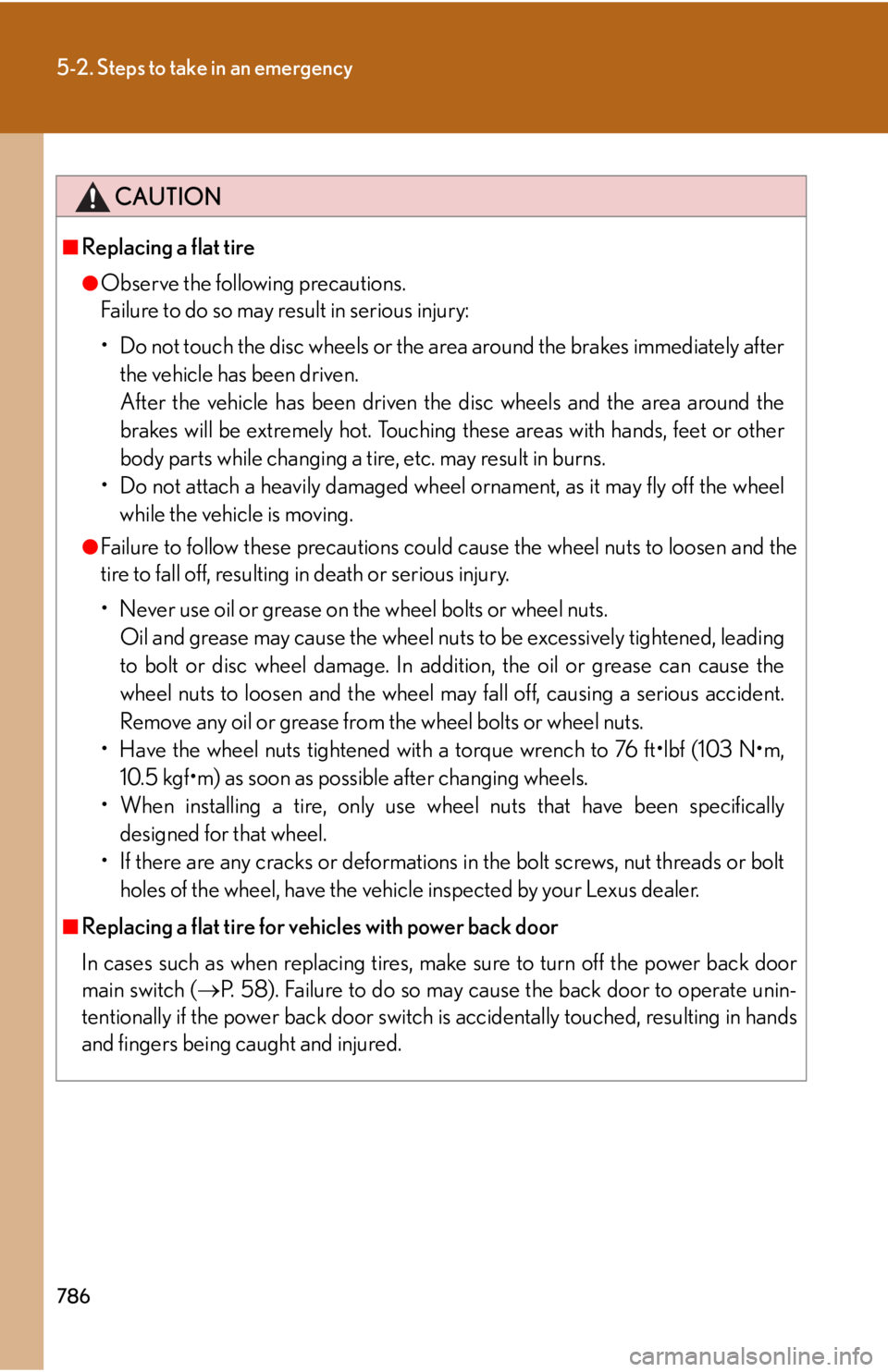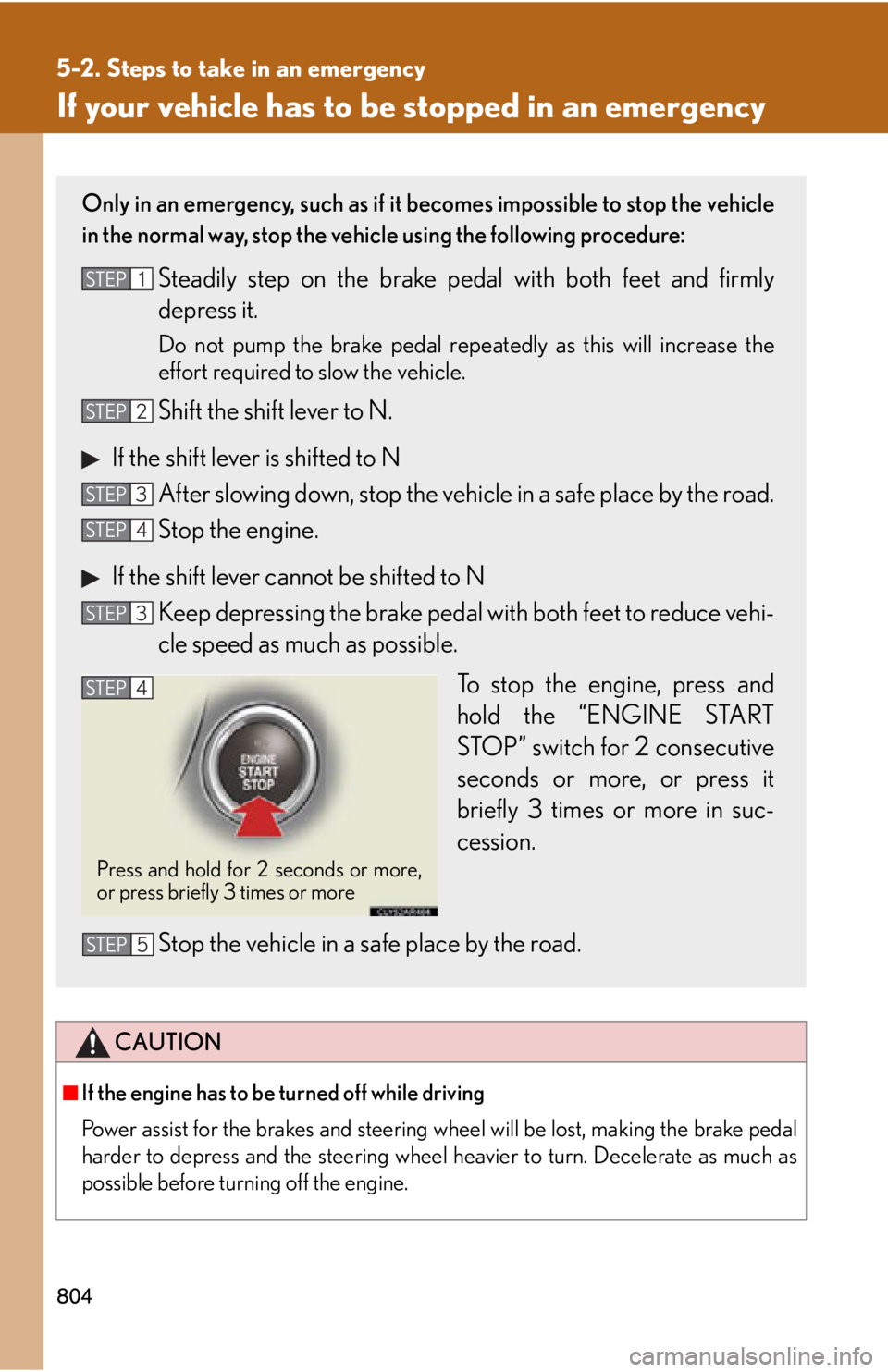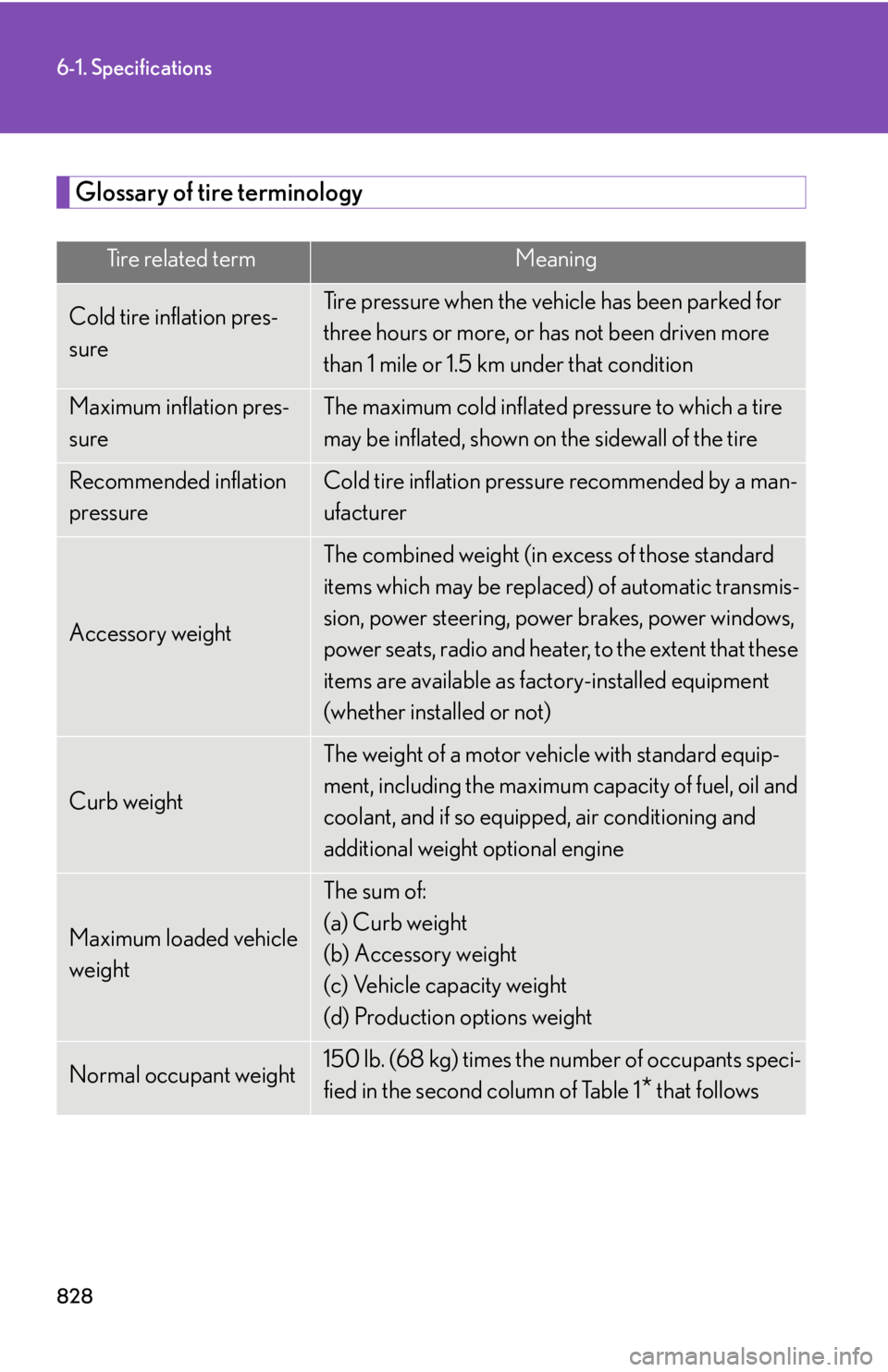Page 751 of 886

5
When trouble arises
7515-2. Steps to take in an emergency
●
If non-genuine Lexus wheels are used (Even if you use Lexus wheels, the tire
pressure warning system may not work properly with some types of tires.)●
If tire chains are used●
Vehicles with a full-size spare tire: If the spare tire is in a location subject to poor
radio wave signal reception●
Vehicles with a full-size spare tire: If a large metallic object which can interfere
with signal reception is pu t in the luggage compartment■
If the tire pressure warning light freque ntly comes on after blinking for 1 minute
If the tire pressure warning light frequently comes on after blinking for 1 minute
when the “ENGINE START STOP” switch is turned to IGNITION ON mode, have
it checked by your Lexus dealer.■
Customization
The vehicle speed linked seat belt reminder buzzer can be disabled.
(Customizable features P. 8 3 4 )
CAUTION■
When the electric power steering system warning light comes on
The steering wheel may become extremely heavy.
If the steering wheel becomes heavier than usual when operating, hold firmly and
operate using more force than usual.■
If the tire pressure warning light comes on
Be sure to observe the following precautions. Failure to do so could cause loss of
vehicle control and result in death or serious injury. ●
Stop your vehicle in a safe place as soon as possible. Adjust the tire inflation pres-
sure immediately.●
If the tire pressure warning light comes on even after tire inflation pressure adjust-
ment, it is probable that you have a flat tire. Check the tires. If a tire is flat, change
it with the spare tire and have the flat tire repaired by the nearest Lexus dealer.
●
Avoid abrupt maneuvering and braking. If the vehicle tires deteriorate, you could
lose control of the steering wheel or the brakes.
■
If a blowout or sudden air leakage should occur
The tire pressure warning system may not activate immediately.
Page 763 of 886
5
When trouble arises
7635-2. Steps to take in an emergency
(If equipped) Indicates that the radar
cruise control system is
unable to judge vehicle-
to-vehicle distance
A buzzer also sounds. • Switch driving mode to
normal.
• If the windshield wipers
are on, turn them off or
set them to a mode other
than AUTO (If
equipped) or high speed
wiper operation.
(Flashes)
(If equipped) Indicates that there is a
high possibility of a fron-
tal collision, or that the
pre-collision braking
function is operating
A buzzer also sounds.
At the same time,
will appear on
the head-up display (the
image flashes). Slow the vehicle by apply-
ing the brakes.
(Flashes)
(If equipped) Indicates that your vehi-
cle is nearing the vehicle
ahead (in radar cruise
mode)
A buzzer also sounds.
At the same time,
will appear on
the head-up display (the
image flashes). Slow the vehicle by apply-
ing the brakes.Wa r n i n g m e s s a g e Details Correction procedure
Page 786 of 886

7865-2. Steps to take in an emergency
CAUTION■
Replacing a flat tire ●
Observe the following precautions.
Failure to do so may result in serious injury:
• Do not touch the disc wheels or the ar ea around the brakes immediately after
the vehicle has been driven.
After the vehicle has been driven the disc wheels and the area around the
brakes will be extremely hot. Touching these areas with hands, feet or other
body parts while changing a tire, etc. may result in burns.
• Do not attach a heavily damaged wheel ornament, as it may fly off the wheel
while the vehicle is moving.●
Failure to follow these precautions could cause the wheel nuts to loosen and the
tire to fall off, resulting in death or serious injury.
• Never use oil or grease on the wheel bolts or wheel nuts.
Oil and grease may cause the wheel nuts to be excessively tightened, leading
to bolt or disc wheel damage. In addition, the oil or grease can cause the
wheel nuts to loosen and the wheel may fall off, causing a serious accident.
Remove any oil or grease from the wheel bolts or wheel nuts.
• Have the wheel nuts tightened with a to rque wrench to 76 ft•lbf (103 N•m,
10.5 kgf•m) as soon as possible after changing wheels.
• When installing a tire, only use whee l nuts that have been specifically
designed for that wheel.
• If there are any cracks or deformations in the bolt screws, nut threads or bolt
holes of the wheel, have the vehicle inspected by your Lexus dealer.■
Replacing a flat tire for ve hicles with power back door
In cases such as when replacing tires, make sure to turn off the power back door
main switch ( P. 58). Failure to do so may cause the back door to operate unin-
tentionally if the power back door switch is accidentally touched, resulting in hands
and fingers being caught and injured.
Page 804 of 886

8045-2. Steps to take in an emergency
If your vehicle has to be stopped in an emergency
CAUTION
■
If the engine has to be turned off while driving
Power assist for the brakes and steering wh eel will be lost, making the brake pedal
harder to depress and the steering wheel heavier to turn. Decelerate as much as
possible before turning off the engine.Only in an emergency, such as if it becomes impossible to stop the vehicle
in the normal way, stop the vehicle using the following procedure:
Steadily step on the brake pe dal with both feet and firmly
depress it. Do not pump the brake pedal repeatedly as this will increase the
effort required to slow the vehicle.
Shift the shift lever to N.
If the shift lever is shifted to N
After slowing down, stop the vehicl e in a safe place by the road.
Stop the engine.
If the shift lever cannot be shifted to N
Keep depressing the brake pedal with both feet to reduce vehi-
cle speed as much as possible.
To stop the engine, press and
hold the “ENGINE START
STOP” switch for 2 consecutive
seconds or more, or press it
briefly 3 times or more in suc-
cession.
Stop the vehicle in a safe place by the road.STEP 1
STEP 2
STEP 3
STEP 4
STEP 3
STEP 4
Press and hold for 2 seconds or more,
or press briefly 3 times or more
STEP 5
Page 816 of 886
8146-1. Specifications
Brakes
* 1
: Minimum pedal clearance when depressed with a force of 112 lbf (500 N, 51
kgf) while the engine is running
* 2
: Parking brake pedal travel when depressed with a force of 67.5 lbf (300 N, 31
kgf)
SteeringPe d a l c l e a r a n c e
* 1
3.5 in. (88 mm) Min.
Pedal free play 0.04
0.24 in. (1
6 mm)
Brake pad wear limit 0.04 in. (1.0 mm)
Parking brake lining wear limit 0.04 in. (1.0 mm)
Parking brake pedal travel
* 2
7
10 clicks
Fluid type SAE J1703 or FMVSS No.116 DOT 3
Free play Less than 1.2 in. (30 mm)
Page 830 of 886

8286-1. Specifications
Glossary of tire terminology Tire related term Meaning
Cold tire inflation pres-
sure Tire pressure when the vehicle has been parked for
three hours or more, or has not been driven more
than 1 mile or 1.5 km under that condition
Maximum inflation pres-
sure The maximum cold inflated pressure to which a tire
may be inflated, shown on the sidewall of the tire
Recommended inflation
pressure Cold tire inflation pressure recommended by a man-
ufacturer
Accessory weight The combined weight (in excess of those standard
items which may be replaced) of automatic transmis-
sion, power steering, power brakes, power windows,
power seats, radio and heater, to the extent that these
items are available as factory-installed equipment
(whether installed or not)
Curb weight The weight of a motor vehicle with standard equip-
ment, including the maximum capacity of fuel, oil and
coolant, and if so equipp ed, air conditioning and
additional weight optional engine
Maximum loaded vehicle
weight The sum of:
(a) Curb weight
(b) Accessory weight
(c) Vehicle capacity weight
(d) Production options weight
Normal occupant weight 150 lb. (68 kg) times the number of occupants speci-
fied in the second column of Table 1
* that follows
Page 831 of 886

8296-1. Specifications
6
Vehicle specifications Tire related term Meaning
Occupant distribution Distribution of occupants in a vehicle as specified in
the third column of Table 1
* below
Production options
weight The combined weight of installed regular production
options weighing over 5 lb. (2.3 kg) in excess of the
standard items which they replace, not previously
considered in curb weight or accessory weight,
including heavy duty brakes, ride levelers, roof rack,
heavy duty battery, and special trim
Rim A metal support for a tire or a tire and tube assembly
upon which the tire beads are seated
Rim diameter
(Wheel diameter) Nominal diameter of the bead seat
Rim size designation Rim diameter and width
Rim type designation The industry manufacturer's designation for a rim by
style or code
Rim width Nominal distance between rim flanges
Vehicle capacity weight
(Total load capacity) The rated cargo and luggage load plus 150 lb. (68
kg) times the vehicle's designated seating capacity
Vehicle maximum load on
the tire The load on an individual tire that is determined by
distributing to each axle its share of the maximum
loaded vehicle weight, and dividing by two
Vehicle normal load on
the tire The load on an individual tire that is determined by
distributing to each axle its share of curb weight,
accessory weight, and normal occupant weight (dis-
tributed in accordance with Table 1
* below), and
dividing by two
We a t h e r s i d e The surface area of the rim not covered by the
inflated tire